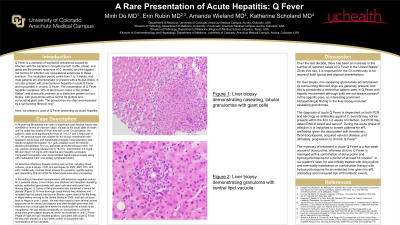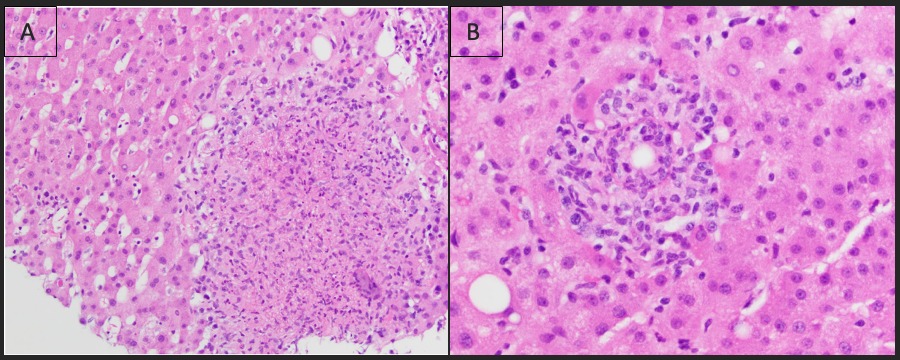Monday Poster Session
Category: Liver
P2599 - A Rare Presentation of Acute Hepatitis: Q Fever
Monday, October 23, 2023
10:30 AM - 4:15 PM PT
Location: Exhibit Hall

Has Audio

Minh Do, MD
CU Internal Medicine Residency Program
Aurora, CO
Presenting Author(s)
Award: Presidential Poster Award
Minh Do, MD1, Erin Rubin, MD2, Amanda Wieland, MD3, Katherine Scholand, MD3
1CU Internal Medicine Residency Program, Aurora, CO; 2McGovern Medical School, Houston, TX; 3University of Colorado, Aurora, CO
Introduction: Q Fever, a global zoonosis caused by C. burnetii, is more recognized in Europe and Asia, but is becoming more prevalent in the United States. Acute hepatitis is one of the several ways acute Q Fever can present. In conjunction with positive serologic studies, the liver biopsy classically shows granulomas with a central fat globule with surrounding giant cells. Granulomas are often encompassed by a surrounding fibrin ring.
Case Description/Methods: A 39-year-old previously healthy Bhutanese man was admitted for two weeks of fever. Initial diagnostic studies were notable for alkaline phosphatase 151 U/L, aspartate aminotransferase (AST) 191 U/L, alanine aminotransferase (ALT) 184 U/L, total bilirubin 2.8 mg/dL, and bilirubin direct 1.8 mg/dL. A CT abdomen/pelvis showed hepatomegaly along with mediastinal, hilar, and axillary lymphadenopathy.
The patient then underwent an extensive infectious disease workup, which was unremarkable, with tuberculosis evaluation also unrevealing. In the setting of elevated transaminases with extensive negative workup for fever of unknown origin, a liver biopsy was obtained and revealed caseating, lobular, epithelioid granulomas with giant cells (A). A few of the granulomas also contained a central fat globule (B).
A more thorough social history was obtained and revealed that the patient had an important animal exposure as he often went to a local goat farm to purchase meat. Q Fever Phase I/II IgM and IgG resulted positive, consistent with acute Q Fever. He was started on a two-week course of doxycycline with subsequent normalization of his liver tests.
Discussion: Acute hepatitis is the presenting manifestation in 12% of acute Q Fever cases reported in the United States. On liver biopsy, granulomas encompassed by surrounding fibrinoid rings are generally present, a distinctive pattern seen in Q Fever with hepatic involvement. In this specific case, an interesting prominent histopathologic finding in the liver biopsy included caseating granulomas.
We hope to encourage clinicians to remain well-informed regarding Q Fever, an increasingly prevalent disease in the US with a multitude of different clinical presentations, including hepatitis, that can be treated effectively when identified in a timely manner.

Disclosures:
Minh Do, MD1, Erin Rubin, MD2, Amanda Wieland, MD3, Katherine Scholand, MD3. P2599 - A Rare Presentation of Acute Hepatitis: Q Fever, ACG 2023 Annual Scientific Meeting Abstracts. Vancouver, BC, Canada: American College of Gastroenterology.
Minh Do, MD1, Erin Rubin, MD2, Amanda Wieland, MD3, Katherine Scholand, MD3
1CU Internal Medicine Residency Program, Aurora, CO; 2McGovern Medical School, Houston, TX; 3University of Colorado, Aurora, CO
Introduction: Q Fever, a global zoonosis caused by C. burnetii, is more recognized in Europe and Asia, but is becoming more prevalent in the United States. Acute hepatitis is one of the several ways acute Q Fever can present. In conjunction with positive serologic studies, the liver biopsy classically shows granulomas with a central fat globule with surrounding giant cells. Granulomas are often encompassed by a surrounding fibrin ring.
Case Description/Methods: A 39-year-old previously healthy Bhutanese man was admitted for two weeks of fever. Initial diagnostic studies were notable for alkaline phosphatase 151 U/L, aspartate aminotransferase (AST) 191 U/L, alanine aminotransferase (ALT) 184 U/L, total bilirubin 2.8 mg/dL, and bilirubin direct 1.8 mg/dL. A CT abdomen/pelvis showed hepatomegaly along with mediastinal, hilar, and axillary lymphadenopathy.
The patient then underwent an extensive infectious disease workup, which was unremarkable, with tuberculosis evaluation also unrevealing. In the setting of elevated transaminases with extensive negative workup for fever of unknown origin, a liver biopsy was obtained and revealed caseating, lobular, epithelioid granulomas with giant cells (A). A few of the granulomas also contained a central fat globule (B).
A more thorough social history was obtained and revealed that the patient had an important animal exposure as he often went to a local goat farm to purchase meat. Q Fever Phase I/II IgM and IgG resulted positive, consistent with acute Q Fever. He was started on a two-week course of doxycycline with subsequent normalization of his liver tests.
Discussion: Acute hepatitis is the presenting manifestation in 12% of acute Q Fever cases reported in the United States. On liver biopsy, granulomas encompassed by surrounding fibrinoid rings are generally present, a distinctive pattern seen in Q Fever with hepatic involvement. In this specific case, an interesting prominent histopathologic finding in the liver biopsy included caseating granulomas.
We hope to encourage clinicians to remain well-informed regarding Q Fever, an increasingly prevalent disease in the US with a multitude of different clinical presentations, including hepatitis, that can be treated effectively when identified in a timely manner.

Figure: A. Liver biopsy demonstrating caseating, lobular granulomas with giant cells.
B. Liver biopsy demonstrating granuloma with central lipid vacuole.
B. Liver biopsy demonstrating granuloma with central lipid vacuole.
Disclosures:
Minh Do indicated no relevant financial relationships.
Erin Rubin indicated no relevant financial relationships.
Amanda Wieland indicated no relevant financial relationships.
Katherine Scholand indicated no relevant financial relationships.
Minh Do, MD1, Erin Rubin, MD2, Amanda Wieland, MD3, Katherine Scholand, MD3. P2599 - A Rare Presentation of Acute Hepatitis: Q Fever, ACG 2023 Annual Scientific Meeting Abstracts. Vancouver, BC, Canada: American College of Gastroenterology.

